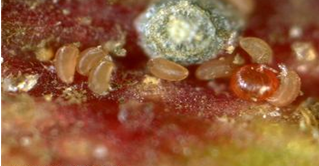Adapted from the article “Eriophyid mites can damage the growth of young prune trees” by Carolyn DeBuse, UC Farm Advisor, Solano and Yolo Counties in the April 2010 Sacramento Valley Prune News.
Eriophyid mites are a group of very small plant feeding mites. The two most common eriophyid mites found in prune orchards are the Plum rust mite (Aculus fockeui) and the Big-beaked plum mite (Diptacus gigantorhynchus). They are so small that you need a 15x hand lens to see them. Their feeding habits often create a leaf curling effect with drying at the edges and a bronzing of the leaf. Studies in prunes have shown that even high populations on mature trees do not decrease yields or fruit quality and natural predators usually keep the numbers of eriophyid mites under control.

Big-beaked plum mites
So why talk about them? Under certain circumstances the damage can affect the growth habit of the tips of branches and reduce the growth of scaffolds and limbs on young trees. The goal for the first 1-3 years of an orchard’s life is to grow the largest trees you can. All management is aimed at promoting growth so when you have a mite that restricts growth it becomes a problem. The eriophyid mite attacks the growing shoot tip, damages emerging leaves, and increases bud breakage at the growing tip creating a ‘witch’s broom effect’ much like a peach twig borer strike but worse because it continues to feed on the newly emerging leaves. The mite feeding slows productive shoot growth on affected limbs for this season and will need to be pruned off during the next dormant season.
Symptoms: Tips of young tree limbs have a yellowish reddish hue. The tip growth is slowed and newly emerging leaves from the terminal bud are deformed and yellowish. Multiple buds just below the terminal bud begin to grow creating a sickly looking witch’s broom.
Identifying the mite: Peel back the emerging leaves on the damaged terminal bud and look for small tear shaped mites with a yellow, pinkish or purplish color using a hand lens of 15x strength or greater. The mites are translucent with only four legs.
Control: Treating early in the season provides more effective control for reducing damage. These mites decline naturally during the hot summer so make sure they are still active when you spray. Control the mite with an application of one of the following; wettable sulfur, sulfur dust or fenbutatin oxide (Vendex®, etc.). Not all miticides will control eriophyid mites. Check with the label or with your PCA to make sure the material you use is labeled for eriophyid mites.
See the UC guidelines for treatment. Care should be taken with the use of any sulfur product during the summer to avoid burning. Do not use sulfur with oil or within two weeks after an oil spray.


Leave a Reply